Final report for FNE16-857
Project Information
In this project the farmers used a no-till drill to plant tillage radish into an existing pasture. The goal was to see what impact the application of tillage radish would have on soil compaction. The farmers planted the tillage radish in 2016 and 2017 both very dry years. Despite the challenges to establishment the soil infiltration tests done in the spring of 2017 suggest that the tillage radish did reduce compaction and increase the soil’s ability to absorb water. A benefit of the project is the discovery that despite dry weather the tillage radish is able to utilize the available fertility from the farm’s pastured poultry and rotational grazing to rapidly establish and to provide a beneficial forage crop during the late fall grazing season. The farmers plan to continue planting tillage radish in the subject fields and other farm fields where soil drainage is poor. This forage will add grazing days to our season and result in less hay purchased for feeding during a dry fall.
Outreach for this project included a field day held on the farm in October 2017.
Introduction:
Several of Apple Creek Farm’s hay fields have been in continuous production for more than 30 years. These fields have been mowed at the same time and in roughly the same pattern each year. On-farm pastures were managed under a continuous graze system with sheep and cows until 2009. As a result soil compaction and depleted nutrients are an issue in nearly all the farm’s fields.
Buxton silt loam is the dominant soil type in the subject fields, which tend to be wet until late in the season. In recent years the farm has increased applications of fertility by adding lime, hen manure and manure from the farm in order to increase organic matter and yields on the hay fields. In the pastures rotational grazing has increased fertility. But these measures alone haven’t addressed compaction in the fields.
Compaction is a problem in hay fields and permanent pastures, but options to address this issue are limited without taking fields out of production and/or expensive equipment upgrades. Current research shows that hardpan can be broken up using a subsoiler. Most sub-soilers need high horsepower equipment that is not available at the right time for tillage or may not be available on this scale farm at all. In the case of both the hayfield and pasture the ideal time for deep tillage coincides with haying operations and the highest stocking rates on the pastures. Therefore subsoiling is less appealing because of the equipment needed and the fact that it can also bring to the surface clods, rocks and other materials which mean additional field preparation. In many cases this may include rock picking, discing, and applying fertility amendments before seeding. This field prep would be difficult at such a busy time of year and would lead the farm to take fields out of production. This would not just be an inconvenience but negatively impact production and consequently the farm’s productivity and bottom line. In the case of Apple Creek Farm this level of field management and taking fields out of production for a period of time also has the potential to jeopardize the certified organic status of some of the livestock on site. This is because the grazing requirements for ruminant livestock mean we must have access to all of our available pastures in any given growing season. These factors led to the idea of exploring alternative means to combat hardpan that are biological rather than mechanical and that can be implemented without adverse impacts on productivity.
This project seeks to understand whether using forage radish to break up hardpan,“mop up” excess nutrients low in the soil profile and increase organic matter can improve the productivity of the farm by reducing costs for mechanical tillage and increase the farm’s net income through improved forage production. It is well documented that forage radish can biodrill deeply in the soil profile. Breaking up hardpan with this action the radish is able to pull upward nutrients that are being held lower in the soil profile. An additional benefit is that this soil improvement could be achieved with efficient use of time during a busy part of Maine’s growing season. This project could help many other farmers in the Northeast improve their pastures and hayfields in a cost effective manner.
There is a growing body of scientific support for using radishes and other bio-drilling crops to meet a variety of soil quality goals. Tillage radish use among both vegetable and livestock producers is on the uptick, but oftentimes is accompanied by tillage of some form at some point in the system. In other words these studies and examples are oftentimes not strictly no-till systems. This project seeks to learn from these past examples (many of which are briefly described below) while also seeking to understand if this method can be used without tilling or taking any land out of production.
Perhaps the most closely related project informing this work is SARE project GNE11-022, Evaluating the use of forage radishes as a pasture improvement tool, which provides some baseline information about efficacy and methods. However, this project was conducted over only 1 year with soil testing occurring first at 12 weeks of forage radish growth and then in the Spring following. In this project several variables differ from the proposed project. In this project both test and control plots will be managed consistent with normal production rather than excluding grazing or haying activities. Additionally seed will not be broadcast, but instead be applied to appropriately fertilized ground using a no-till drill to ensure proper seed depth and increasingly likelihood of germination. By conducting this project over two years a larger body of data will be used to measure outcomes.
Several additional resources and recent studies have looked at the potential for forage radish to meet the overall goals described in this project, specifically over the past several years. A summary of some of those projects and lessons learned to inform this project are described below.
LNE11-312, No-till, No-herbicide Planting of Spring Vegetables Using Low Residue Winter Killed Cover Crops . This project looked at the potential for forage radish use in vegetable production, primarily in the mid-Atlantic, to achieve many of the same desired goals as this project. This project was particularly informative in determining best seeding dates in Maine.
ONE13-179, Investigating forage radish and compost as a means of alleviating soil compaction in established bramble and blueberry fields. This project gave a clear understanding of potential barriers to stand establishment in sod systems and again took place in crops for human consumption, though with many of the same goals in mind.
ONE14-197, No-Tilling Grazing Brassicas into existing pastures: Remediation of sward and soil health for pastures. This SARE project is closely related to this proposed project, though the primary objectives are slightly different. Fay’s outreach as part of this ongoing grant was helpful in establishing the methods for this current grant request.
GNE11-022 Evaluating the use of forage radishes as a pasture improvement tool. This SARE project showed some promise and insight into the use of forage radish to reduce compaction in pastures and further study was recommended. Our current project seeks to build on this work.
Renovation Practices To Improve Rainfall RANGELANDS Effectiveness on Rangeland and Pastures, Texas Agricultural Extension Service C. Wayne Hanselka, S. D. Livingston and David Bade This publication examines the link between poor water infiltration and soil compaction as evidenced by the increase of undesirable plants in a given field. A variety of mechanical options to combat compaction are included in this overview.
This project will evaluate the impact of applications of manure and forage radish on soil compaction in an established hay field and pasture. Using a no-till drill the forage radish will be applied using readily available equipment during ideal growing windows without the use of tillage which would remove the field and pasture from normal use. The project, begun during the 2016 growing season has yielded useful information about the benefits of planting annual forages such as tillage radish to reduce compaction and provide necessary forage during dry weather.
The project participants include farmers, Abby Sadauckas and Jake Galle. Jake is the primary equipment operator on the farm and as such operated the no-till drill. Both farmers worked with technical advisor, Katy Green of Maine Organic Consulting to take soil tests and to perform soil infiltration tests.
Cooperators
Research
In this project two subject fields, each with a control and test plot were used to evaluate the impact of applications of manure and forage radish on soil compaction. Soil tests from control and tests plots in each were taken and analyzed at the start of the grant. The soil tests included pH; Lime Index; Available Nitrogen, Phosphorus, Potassium, Calcium, Magnesium, Sulfur, Boron, Copper, Iron, Manganese, Sodium, Zinc by modified Morgan method; Organic matter; Lead scan; Calculated Cation Exchange Capacity, Texture, Aggregate Stability, Plant-available Water, Active Carbon/Microbial Biomass, Potential Nitrogen Supply, and an evaluation of Soil Compaction measurements.
Each year the farmers collected and sent in samples of manure collected from winter livestock housing that has been stacked and turned in preparation for field application. Results from these tests ascertained the nutrients contained in order to analyze utility of application and source any additional amendments to meet fertility needs of the crop and ensure rapid radish establishment. Ensuring the field is properly fertilized was an essential tool in the success of radish seeding and was considered an important aspect of this project.
In each of the subject fields ring infiltrometer readings were taken in 3-5 randomized locations for both the control and test plots. A ring infiltrometer method was used as opposed to a penetrometer because we felt the results provided by monitoring water infiltration rates were more representative of the changes to the field as a whole. Penetrometer readings in fields with recent tillage radish applications are open to bias depending on whether or not a radish hole is hit in the reading. In both the test and control plots the ring infiltrometer were driven in and tests conducted to measure baseline infiltration rates at the start of the project, in Spring of year 2 and a final test in the Spring of year 3. Both of the farmers and the technical advisor participated in these tests to ensure accuracy in administration and data collection.
In the hay field the farmers aim was to remove first crop by mid-July in order to allow enough time for manure application and seed drilling within 4 weeks given that ideal planting time in our climate for forage radish is the first week of August. Steps to complete this objective included loading and hauling manure to the field, spreading manure and picking up the no-till drill from its storage site in Unity. In the permanent pasture test plot grazing was conducted as part of an intensive rotational grazing system in order to achieve a stubble that will allow the emerging radish to compete with existing plants. The grazing rotation was planned to coincide as much as possible with hay harvest to enable the use of the no-till drill in both the hayfield and pasture within a week or so. The farmers planned to clip the test pasture in order to be doubly sure that the tillage radish can be competitive with existing grass species. The aim of first year introduction of the tillage radish was to plant at the optimal time, typically the first week in August, in order to allow for maximum growth. In the hay field the radish was allowed to grow and the farmers forewent a second crop of hay. In the pasture the radish was treated like forage and leaves were grazed once they reach a height of 4-6”. Grazing was done in short enough in duration that the radish continued to grow well into the fall. In this plot the farmers hoped to use Graza radish seed, which is said to be better for grazing and to stand up a later into the season. In the hayfields no specific variety was being sought, but seeds purchased had to comply with the organic standards in order to maintain organic certification of these fields.
The methods were re-evaluated throughout the fall and spring, adjustments made and replicated a second year.
YEAR ONE
The 2016 season was a challenging one given the lack of rain. This certainly impacted the results of the project overall. The results of the planting varied dramatically between the two test fields. In the off-farm hayfield (Williams field) hay was taken off earlier than anticipated, this allowed the farmers to get the field planted by mid-July. In a normal year this would have allowed ample time for substantial growth. Due to the dryness though the germination was delayed.



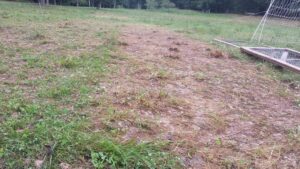
In the East Pasture the farmers were able to clip the field prior to planting and then run broilers through it both before and after planting (see narrative above). The added fertility of the broilers and mulch provided by clipping enabled rapid germination and significant growth of the radishes, despite the noted compaction. The growth and coverage in the field was not uniform and certainly reflected the movements of the broilers and their shelters through the pasture. The forage provided by the radish proved extremely valuable as little of the farm was available for grazing due to dry weather. Sagadahoc County, where the farm is located was designated a primary natural disaster area on October 7, 2016 due to the drought.
The control and test plots of the hay field (Williams Field) were soil tested in the fall of 2015. Tests were conducted using a soil probe, collecting multiple core samples from various areas of each of the test and control plots. Results of those soil tests came in February 2016 and were used as the baseline data for the project. On April 22, technical advisor Katy Green came to the farm to conduct additional soil tests on the control and test plots in the East Pasture. The results of these tests were returned in May of 2016. It was decided to use rotational grazing in the East Pasture to apply needed fertility. Soil test results for the Williams field and for the East Pasture are included using the hyperlinks.
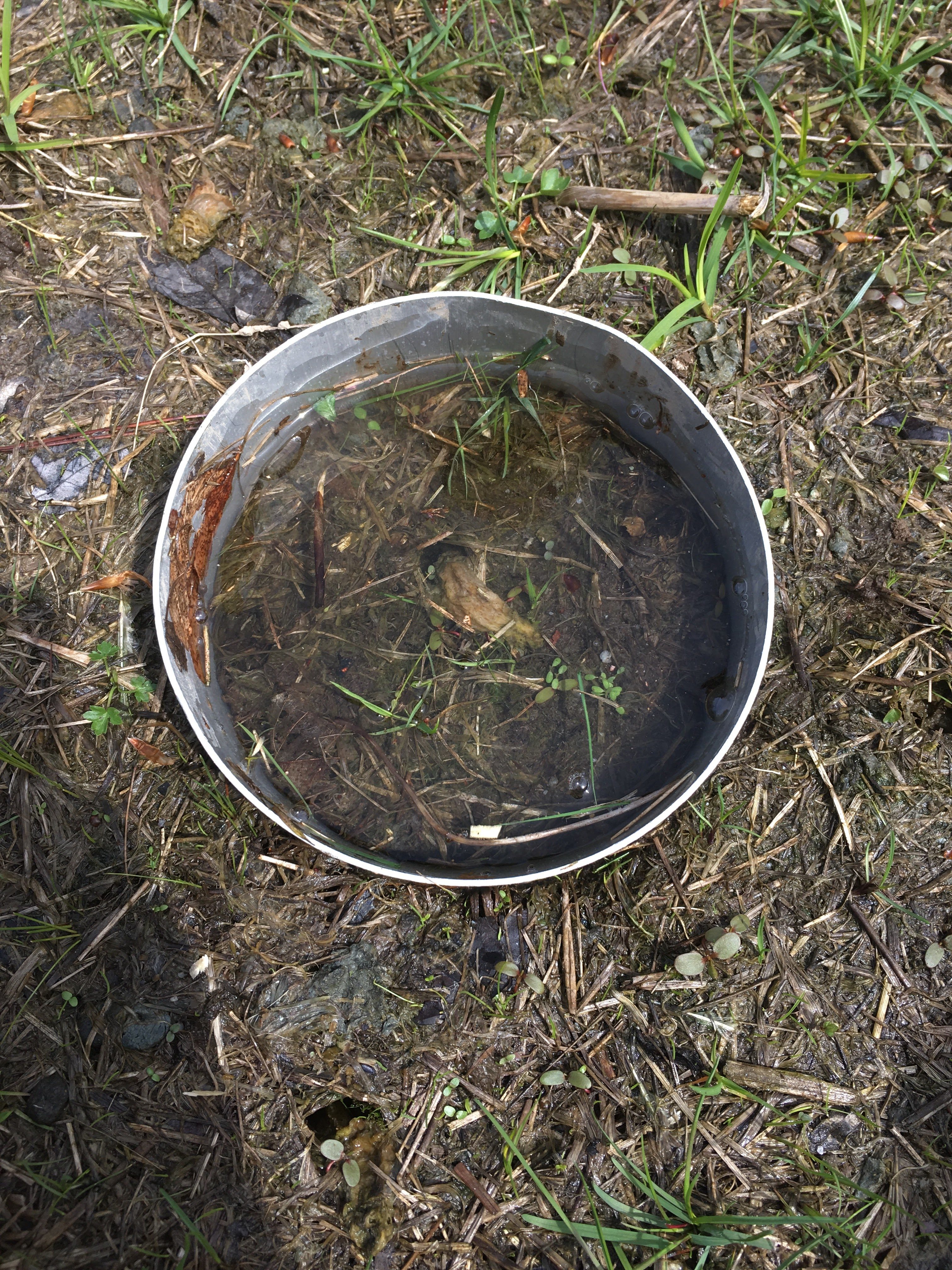
On May 26th 2016, the farmers, along with their technical advisor competed soil infiltration tests. Using page 7 of this document as reference the farmers performed and recorded infiltration readings from four random plots in each of the control and test plots of both the hayfield (Williams) and the East Pasture. These were done using rings borrowed from our local University of Maine Cooperative Extension office. Results appear below and were recorded in a spreadsheet, Data Collection - Infiltration baselines
| 5/26/16 | 1:01 | 1:02 | 2:01 | 2:02 | 3:01 | 3:02 | 4:01 | 4:02 | Notes |
| E Pasture Control | 6:05 | 30 minutes | 33 minutes | 60:00 + | 4:02 took at least 10 minutes for initial water to drain | ||||
| E Pasture Test | 60:00 + | 60:00 + | 7:44 | 40 plus minutes |
1:02 & 2:02 pulled up all the soil within the ring when ring was removed.
|
||||
| Williams Control | 5:07 | 8:15 | 10:40 | 8:39 | |||||
| Williams Test | 6:13 | 2:47 | 4:36 | Rotted wet area closest to house. | Many snails & slugs in this field |
The results supported the hypothesis that compaction exists in both fields, however the rate of infiltration was so much slower in the East pasture that the results indicated even more compaction than anticipated.
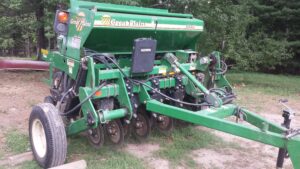
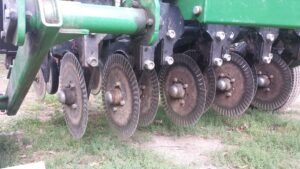
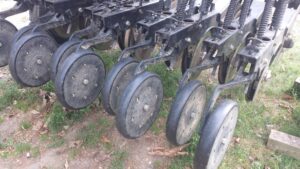
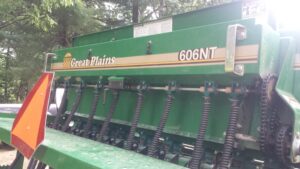
On July 4 hay was baled in the Williams Field. At this point in the season the farmers decided to get the no-till drill and apply the tillage radish as soon as possible due to dry weather and rain forecasted for the following week. The farmers planned to spread manure after seeding when able. On July 14 Jake seeded Williams Field using a Great Plains 606NT drill part of the Maine Grass Farmers Network (MGFN) shared use equipment pool. Jake ran the drill north to south with hopper at 50%. He then ran the drill east to west with the hopper at 65%. The drill’s coulters were set at a depth of ½”. On July 17th approximately a ½” of rain fell on the field. Plans to spread manure were put off as the weather continued to be dry without rain fall for over a month and a half.
In the East pasture our ewes rotationally grazed through the test plot from July 13-15. Then they grazed the control plot from July 15-18. Following their grazing Pete Galle (Jake’s father) clipped the test plot to ensure consistent stubble length. On July 19 Jake seeded the test plot using the no-till drill at depth of 1/2". Again the drill was pulled East to West and then North to South to cover the entire test plot. The hopper was set at 70% open.
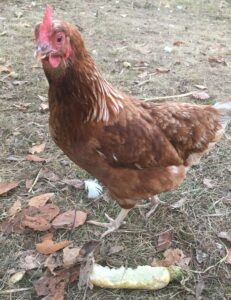
After seeding several groups of broilers were rotated through both the control and test plots during the window of germination (beginning August 1st). Following the broiler rotations the radish was permitted to grow until the lambs and kids began
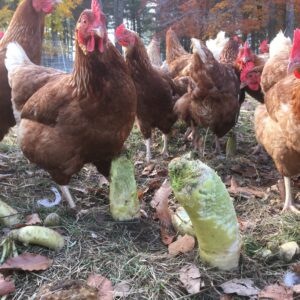
rotations through the test plot from September 30 - October 12. During this time they removed the leafy portions of the plants leaving the radishes in the ground and any portions above ground. The farm’s laying hens moved into the test plot on October 20 where they remained into November. In photos (below) from November 5th and 8th it can be seen that the hens began to remove radishes from the ground and/or began eating the in-ground radishes. Where fallen leaves collected on the edge of polynets (portable fencing) the radish continued to grow, protected from frost.
YEAR 2
On May 4, 2017 the farmers, along with their technical advisor competed soil infiltration tests using the same method as in Year 1. The spring had been quite wet and despite this the performed and recorded infiltration readings from four random plots in each of the control and test plots of both the hayfield (Williams) and the East Pasture indicated improved drainage, see below and updated Data-Collection-Infiltration-baselines1.
| 5/4/17 | 1:01 | 1:02 | 2:01 | 2:02 | 3:01 | 3:02 | 4:01 | 4:02 | Notes |
| E Pasture Control | 0.18 | 5:59 | 1:55 | 3:22 | 38.33 | 1:24 | South end of control plot seems drier overall | ||
| E Pasture Test | 1:26 | 30 min | 30 min | 10:21 | |||||
| Williams Control | 4:25 | 5:19 | 21:19 | 2:38 | |||||
| Williams Test | 3:12 | 1:33 | 2:58 | 30 min + | at 17 minutes the initial water has drained out |
The improved rates were really exciting and the farmers look forward to performing another soil infiltration test in the Spring of 2018 to see if this trend in improved drainage continues. It was surprising to find that some of the tillage radish had overwintered either as seed or as immature plants. These photos, taken on 5/4/17 indicate some of the tillage radish that was already growing in the East Pasture. 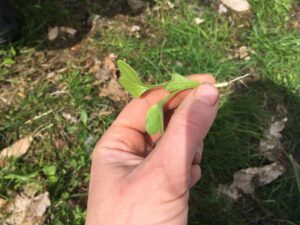
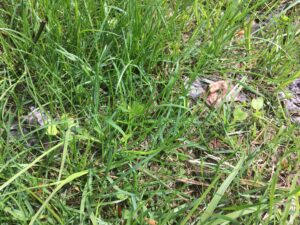
This could have been due to the extremely dry conditions in 2016 or the fact that leaves covered some sections of the tillage radish through the winter and protected them from being killed by the cold.
Throughout the months of May and June the East Pasture was rotationally grazed and fertilized using sheep, goats and pastured poultry (broilers and geese).
On July 2nd grass was cut in the hayfield (Williams). The season was dry like 2016, but a few rain events were recorded including a light rain on July 18 which the farmers hoped would help with germination. On July 21 tillage radish was drilled into the East Pasture and the following day it was drilled into the hayfield (Williams). By July 28 tillage radish was coming up in East Pasture. A light rain was recorded on August 5 and it continued over night. Additional rain fell on August 18. The sheep were used to graze a patch of smart weed (where no forage radish had come up) from August 22-24. On September 1st three tons of lime was spread on each of the test plots. At this time it was noted that seed had germinated and was coming up in the Williams Field, though not nearly as much as in the East Pasture.
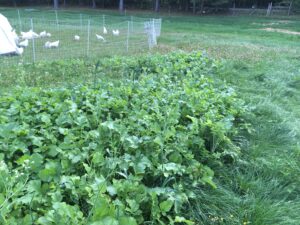
The farmers continued to rotationally graze the East pasture, with the exception of the test plot. These images from mid-September shows the vigorous growth of the forage radish. It should be noted that the radish grew unevenly across the test plot as a whole. Some areas grew very densely while others had noticeably smaller plants. The area grazed by the sheep in late August (that had been overrun by smart weed) had great growth, though much of it was less mature than other areas of the pasture where competing weeds or grasses were not as much of a problem.
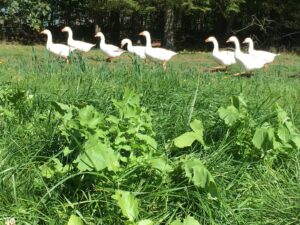
The East Pasture continued to be grazed with the exception of the test plot until after our October 5th farm tour. The farm tour was held in conjunction with MOFGA and the Maine Grass Farmers' Network. It was noted during the farm tour that the 2 years of data are likely not enough to prove definitively that forage radish reduced compaction in the East Pasture. However, the farmers found added benefits in that the radish provided a much needed fall forage that survived multiple grazings by all their livestock. In addition it was noted by farm tour leader, Rick Kersbergen of the University of Maine Cooperative Extension that the tillage radish with its large leaves likely was contributing to increased photosynthesis for the entire pasture. This is an idea that bears examination.
On October 10th we began grazing through the test plot with our sheep. The included photos show the size of the radishes present at that time and then distribution of them through the test plot. The sheep grazed the pasture and left the radishes (or the tubers themselves) undisturbed. This allowed the radishes to continue growing through frost.
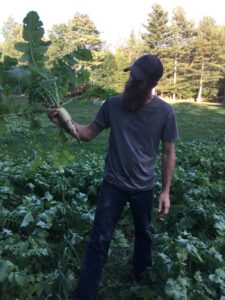
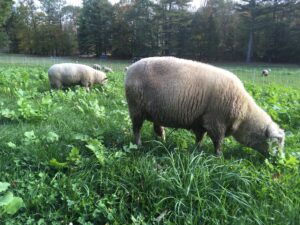
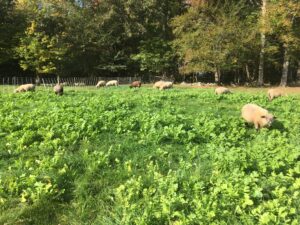
In both years the forage radish germinated well in the East Pasture despite the lack of rain. This leads us to believe that the use of forage radish will continue to be beneficial to our farm in order to provide forage for livestock in the driest months of August and September. It also indicates that the radish is able to "mop up" readily available nutrients and manure residue following our pastured broilers. The timing of planting has worked well as it is relatively easy to get the no-till drill and run it in the test plots. Pick-up, seeding and return of the drill can happen in a 36-48 hour period if conditions such as weather permit it. This is a very small amount of time for the yield and benefits of this crop.
The forage radish grows at an uneven rate. It is hard to say what factors determine this growth rate, but competition from weeds (ie smart weed) and lack of fertility are likely. The radish definitely needs readily available fertility as evidenced by the lack of growth in both years at the off-farm hayfield (Williams).
Results indicate improved soil drainage after one year's application. The farmers are interested to see the results of the infiltration tests in Spring 2018 to see if an additional year's data supports a conclusion.
This project used available equipment (no-till drill) and integration of forage radish species to increase organic matter, break up hardpan and aggregate soil nutrients without taking fields out of production. This provided the benefits of subsoiling with additional benefits of radish, specifically nutrient capture and retention. The project results indicated that planting the tillage radish can improve infiltration rate in soils. The increased rate of absorption indicates a reduction of soil compaction. The ease of applying manure through rotational grazing and of applying the tillage radish through use of the no-till drill made the implementation of this project realistic and attainable. The tillage radish performed well in the East Pasture, despite the lack of rain in both years. This demonstrates the utility of the plant in mopping up available nutrients and providing an annual forage. This forage will add grazing days to our season and result in less hay purchased for feeding during a dry fall. The data collected suggests that the tillage radish did increase soil absorption and reduce hardpan. Soil tests and soil infiltration tests performed in the spring of 2018 will provide additional data.
Education & Outreach Activities and Participation Summary
Participation Summary:
Learning Outcomes
Abby Sadaukus A. Jacob Galle, farmers at Apple Creek Farm LLC, learned that forage radish has a large impact on soil infiltration even with incomplete establishment in existing hay fields.
Project Outcomes
The farmers plan to continue planting tillage radish in the subject fields and other farm fields where soil drainage is poor. This forage will add grazing days to our season and result in less hay purchased for feeding during a dry fall.